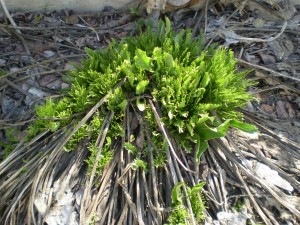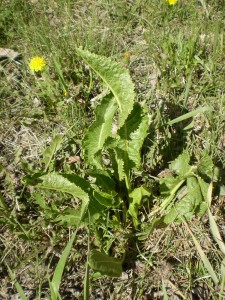Part I: Horseradish as Weed
Horseradish is a common weed in Edmonton, as invasive as it is delicious. The plant is pretty easy to identify by its distinctive curly leaves. If allowed to flourish, they eventually grow into wild, drooping masses that look like Sideshow Bob’s hair. There happens to be a particularly robust example in a friend’s back alley. I visited it this morning to see if my clumsy attempt at harvesting it last summer had killed it. As you can see, it’s doing fine. You can also see all the dead stalks from last year’s growth around the base. It’s a very prodigious plant.
 Last summer I was invited to help myself to the spicy root of the above plant. I had no idea what I was doing, but in August I cut away some of the growth, dug through the hard gravel, and hacked a few good chunks of root out. I used some, grated and mixed with vinegar, on barbequed steak that night. The rest I left in large pieces and froze. The taste was unmistakably horseradish, but with a fairly pronounced, bitter, woody taste. There is heat, but the mustard-flavour is pushed into the background by the woody taste.
Last summer I was invited to help myself to the spicy root of the above plant. I had no idea what I was doing, but in August I cut away some of the growth, dug through the hard gravel, and hacked a few good chunks of root out. I used some, grated and mixed with vinegar, on barbequed steak that night. The rest I left in large pieces and froze. The taste was unmistakably horseradish, but with a fairly pronounced, bitter, woody taste. There is heat, but the mustard-flavour is pushed into the background by the woody taste.
Part II: How to Cultivate Horseradish
Since that first taste of semi-wild horseradish last summer I have done a little research.
Usually the root is harvested in the fall, after the first frost has killed off all the leaves. This is done for a few reasons: it makes harvesting easier, because you don’t have to hack through the fresh stalks and leaves to get to the root; it maximizes the growing season and therefore the size of the root; and apparently the frost helps develop a more pungent flavour.
Ideally the entire root is pulled up every year, and then one of the small offshoots is replanted. Apparently older roots tend to taste woody, which explains my experience last summer. Unfortunately, the above-mentioned plant is so well-established it would take an excavation crew of twenty men to pull up the entire root and replant.
Part III: Liberating Wild Horseradish
 Later this morning, I stumbled across another, smaller horseradish plant, growing on a city-owned patch of lawn, just a few feet from the sidewalk.
Later this morning, I stumbled across another, smaller horseradish plant, growing on a city-owned patch of lawn, just a few feet from the sidewalk.
I considered the Sisyphean life-cycle of this plant: grow, get mowed by city worker, grow, get mowed, et c.
I decided I would liberate this horseradish. I dug it up and replanted it in an inconspicuous location close to my house so that I can harvest it properly every year. (You may think that changing its naturally-occurring, semi-wild state to one of strict cultivation is the opposite of “liberating”. Let’s say I liberated it from neglect. And lawnmowers.)
The root was much, much longer than I expected. As I was digging on public property, and worried I was drawing attention, I rushed the job and accidentally snapped the root, leaving a few inches in the soil. It seems that to pull up even a modest horseradish root, you have to be prepared to dig a hole a foot wide and a foot deep. At this point my re-located horseradish is looking a little sickly. I gave it fresh soil and water. Hopefully it will pull through to garnish my steaks.